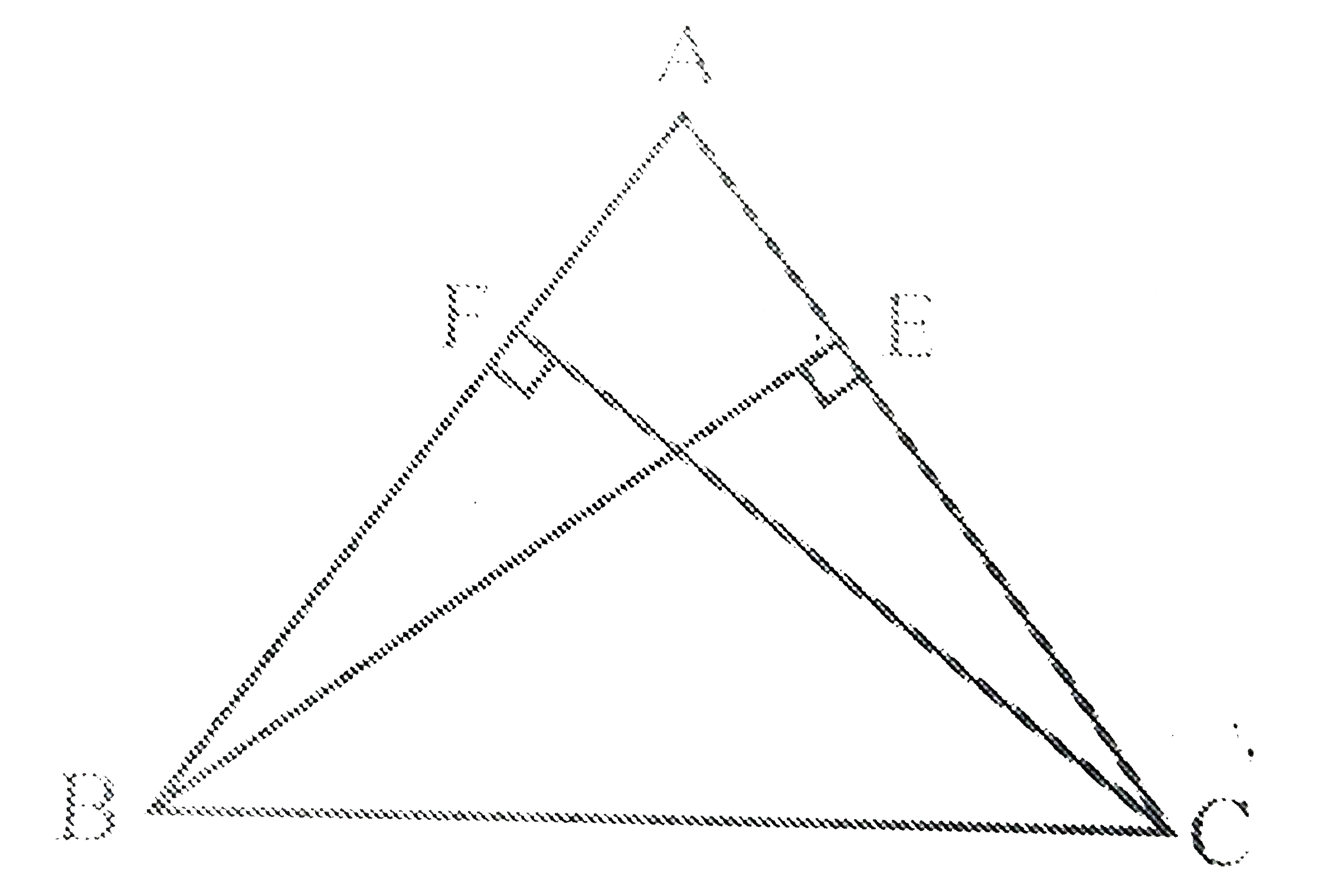In a scalene triangle ABC , AD and CF are the altitudes drawn from A and C on the sides BC and AB repectively.If the area of the triangle ABC and BDF are 18sq.units and 2 sq. units respectively and DF = 2√2 , then R =
94
92
9
none of these
To solve the problem step-by-step, we will follow the reasoning provided in the video transcript while ensuring clarity in each step.
1. Understanding the Problem: We have a scalene triangle ABC with altitudes AD and CF drawn from points A and C to sides BC and AB, respectively. We know the areas of triangle ABC (18 sq. units) and triangle BDF (2 sq. units), and DF = 2√2.
2. Area of Triangle BDF: The area of triangle BDF can be expressed using the formula:
Area=12×base×height
Here, we can take BD as the base and BF as the height. Thus:
2=12×BD×BFsinB
Rearranging gives:
BD×BFsinB=4
3. Relating Areas of Triangles: The area of triangle ABC can also be expressed as:
AreaABC=12×BC×AD
Since we know the area is 18, we can write:
BC×AD=36
4. Using the Area of Triangle BDF: From the area of triangle BDF, we can express BD in terms of BF and sin B:
BD=4BFsinB
5. Finding Relationships: We know that:
AreaABC=18=12×BC×AD
We can express BC in terms of AD and vice versa.
6. Using Cosine and Sine: We know that:
cosB=BDbandsinB=BFb
where b is the length of side AC.
7. Finding Values: From the area of triangle BDF, we can derive:
cos2B=19⟹cosB=13
Using the Pythagorean identity:
sin2B+cos2B=1⟹sin2B=1−19=89⟹sinB=2√23
8. Finding Side Lengths: We can find the length of side BD using the relationship:
DF=bcosB=2√2⟹b=2√2cosB=6√2
9. Finding the Circumradius R: The circumradius R can be calculated using the formula:
R=b2sinB
Substituting the values we found:
R=6√22×2√23=6√24√23=6×34=184=92
Conclusion:
The value of R is 92.
Area=12×base×height
Here, we can take BD as the base and BF as the height. Thus:
2=12×BD×BFsinB
Rearranging gives:
BD×BFsinB=4
AreaABC=12×BC×AD
Since we know the area is 18, we can write:
BC×AD=36
BD=4BFsinB
AreaABC=18=12×BC×AD
We can express BC in terms of AD and vice versa.
cosB=BDbandsinB=BFb
where b is the length of side AC.
cos2B=19⟹cosB=13
Using the Pythagorean identity:
sin2B+cos2B=1⟹sin2B=1−19=89⟹sinB=2√23
DF=bcosB=2√2⟹b=2√2cosB=6√2
R=b2sinB
Substituting the values we found:
R=6√22×2√23=6√24√23=6×34=184=92
The value of R is 92.
Topper's Solved these Questions
- PROPERTIES OF TRIANGLES AND CIRCLES CONNECTED WITH THEMBOOK - OBJECTIVE RD SHARMA ENGLISHCHAPTER - PROPERTIES OF TRIANGLES AND CIRCLES CONNECTED WITH THEMEXERCISE - SOLVED MCQ
2 Videos
- PROPERTIES OF TRIANGLES AND CIRCLES CONNECTED WITH THEMBOOK - OBJECTIVE RD SHARMA ENGLISHCHAPTER - PROPERTIES OF TRIANGLES AND CIRCLES CONNECTED WITH THEMEXERCISE - Section II - Assertion Reason Type
13 Videos
- PROPERTIES OF TRIANGLES AND CIRCLES CONNECTED WITH THEMBOOK - OBJECTIVE RD SHARMA ENGLISHCHAPTER - PROPERTIES OF TRIANGLES AND CIRCLES CONNECTED WITH THEMEXERCISE - Chapter Test
55 Videos
- PLANE AND STRAIGHT LINE IN SPACE BOOK - OBJECTIVE RD SHARMA ENGLISHCHAPTER - PLANE AND STRAIGHT LINE IN SPACE EXERCISE - Chapter Test
31 Videos
- REAL FUNCTIONS BOOK - OBJECTIVE RD SHARMA ENGLISHCHAPTER - REAL FUNCTIONS EXERCISE - Chapter Test
58 Videos
Similar Questions
In the given triangle P, Q and R are the mid points of sides AB, BC and AC respectively. Prove that triangle PQR is similar to triangle ABC.

View SolutionIn Fig. 3, the area of triangle ABC (in sq. units) is :
View SolutionD, E and F are the mid-points of the sides BC, CA and AB respectively of triangle ABC. Prove that:
area of BDEF is half the area of ΔABC.
View SolutionIn a ΔABC,D,EandF are the mid-point of sides BC, CA and AB respectively. If area of ΔABC=16cm2, find the area of trapezium FBCE
View SolutionIn an acute angle triangle ABC, AD, BE and CF are the altitudes, then EFa+FDb+DEc is equal to -
View SolutionIn triangle ABC,ADandBE are the medians drawn through the angular points A and B respectively. ∠DAB=2∠ABE=36∘ and AD=6 units then circumradius of the triangle is equal to
View SolutionIn a triangle ABC,vertex angles A,B,C and side BC are given .The area of △ABC is
View SolutionIn a triangle ABC, ab and c are the sides of the triangle satisfying the relation r1+r2=r3−r then the perimeter of the triangle
View SolutionABC is an isosceles triangle in which altitudes BE and CF are drawn to equal sides AC and AB respectively (see Fig. 7.31). Show that these altitudes are equal.

View SolutionAL, BM and CN are perpendicular from angular points of a triangle ABC on the opposite sides BC, CA and AB respectively. Δ is the area of triangle ABC, (r ) and R are the inradius and circumradius.
If perimeters of ΔLMNandΔABCanλandμ, then the value of λμ is
View Solution
